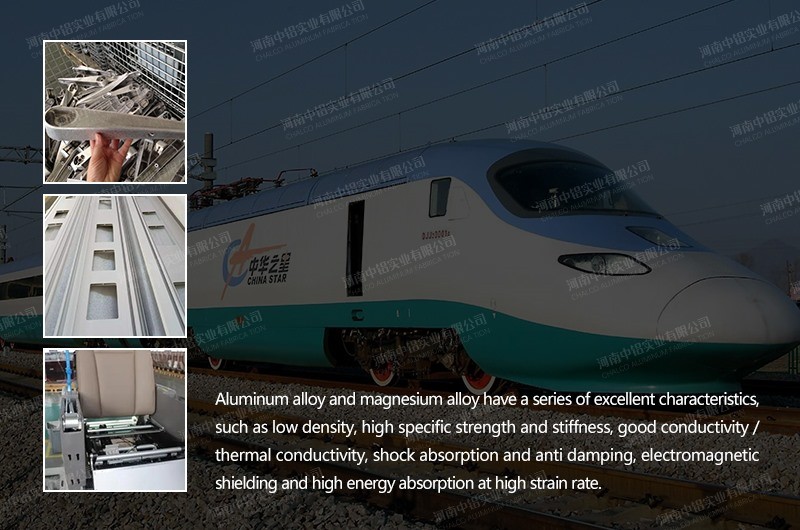
86 17344894490
service@chalcoaluminum.com
- Aluminum Forgings for Rail Vehicles
- Aluminum plate sheet for rail Rail vehicles
- Aluminum Profile for Rail Vehicles
Aluminum alloy in rail transit equipment
Aluminum alloy and magnesium alloy have a series of excellent characteristics such as low density, high specific strength and specific stiffness, good conductivity / thermal conductivity, shock absorption and damping resistance, electromagnetic shielding and high energy absorption at high strain rate. Therefore, they are widely used in aerospace, rail transit, shipbuilding industry, 3C electronic products and other fields. Aluminum alloy and magnesium alloy, especially aluminum alloy, are the first metal structural materials used for lightweight transportation equipment. At present, the high-speed train body in various countries has basically adopted aluminum alloy frame. In addition, the car

Aluminum alloy in rail transit equipment
Body top cover, gearbox box and many other parts have also been made of aluminum. The proportion of magnesium alloy is smaller, only 1.75 ~ 1.85 kg / m3, about 2 / 3 of aluminum, 2 / 5 of titanium alloy and 1 / 4 of steel. The lightweight application potential is even greater [8]. In China, magnesium alloy technology has been adopted for interior parts such as high-speed railway vent fence, sleeper frame and luggage rack. In foreign countries, a series of magnesium alloy parts such as seats, pedals and handrails have been successfully applied on ice high-speed trains in Germany and TGV high-speed trains in France. It can be seen that magnesium alloy has the potential to replace aluminum alloy as a new material for rail transit in a certain field.
Aluminum alloy has been widely used in rail transit equipment products in various countries because of its light weight, corrosion resistance and good formability, mainly including car body and parts with lightweight demand.
The development of large aluminum alloy profile production technology makes it possible for train modernization and lightweight. For rail vehicles, the weight of vehicle body structure accounts for about 15% ~ 30% of the weight of the whole vehicle. Therefore, vehicle body weight reduction is of great significance to vehicle speed increase. In Japan, the complex thin-walled porous hollow profile produced by 6n01 alloy (i.e. 6005 alloy) with better extrusion performance, welding performance and stress corrosion performance has been developed, which has successfully replaced 7N01 and 7003 profiles and is widely used in car body floor, side plate and roof
Plate structure. In Europe and America, al-mg-si6005a extruded profile with good extrusion performance and simplified production process is mainly used for aluminum alloy car body, which effectively solves the problem of stress corrosion on the premise of maintaining strength. In addition, 6061, 6063, 6082 and 6085 extruded profiles have gradually been popularized. In terms of body plates, 5083 deformed aluminum alloy is the most widely used.
Aluminum alloy parts
With the upgrading of rail transit equipment, its weight reduction is not limited to the car body, and more parts made of traditional steel materials have been replaced by new high-strength aluminum alloys. At present, the gear box, air spring support, axle box body, motor end cover and other parts of ice in Germany, Shinkansen in Japan and TGV in France are generally made of high-strength aluminum alloy. China's "Blue Arrow" and "China Star" high-speed trains developed during the ninth five year plan also use a large number of air trains made of aluminum alloy materials
Core floor, side baffle, motor end cover, motor fan, gearbox, etc. With the continuous development of rail transit equipment in the direction of high speed and heavy load, there is an urgent demand for lightweight bogie components such as traction motor, wheel set, transmission plate, axle box body and traction rod. Cast aluminum alloy and forged aluminum alloy are increasingly widely used in these components, and forged aluminum alloy has more advantages in strength, elongation and impact toughness. The materials used for aluminum alloy forgings are mainly 2A14, 6082 and 7050, 2A14 aluminum alloy
The forging has moderate strength after heat treatment and is suitable for parts with large load; 6082 aluminum alloy forging has good welding performance and is suitable for welding with other parts; 7050 aluminum alloy forgings have excellent comprehensive mechanical properties and stress corrosion resistance, and are suitable for dynamic load parts.
7050 high strength aluminum alloy is also used to produce the key part of the wheel set hollow shaft drive device - the drive plate. The traditional transmission plate structure is a large steel forging with a mass of 100 kg. After using aluminum alloy, the mass is only about 35 kg. As an important part of the unsprung mass of the bogie, its weight reduction plays an obvious role in improving the dynamic performance of the whole vehicle.

Free offer of products, welcome to consult at any time, we will give the first reply.Our Email:
